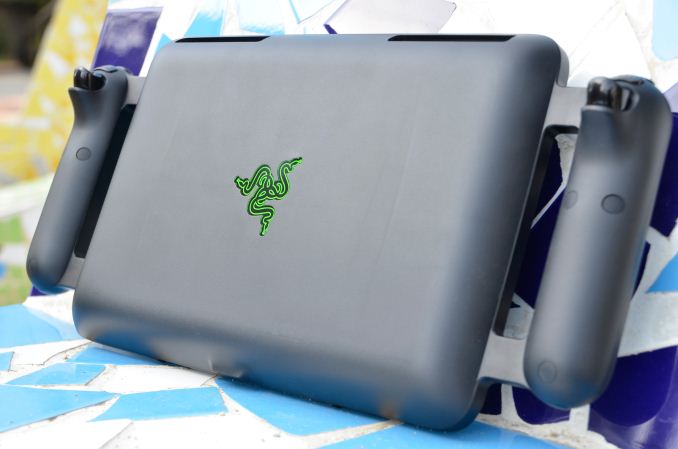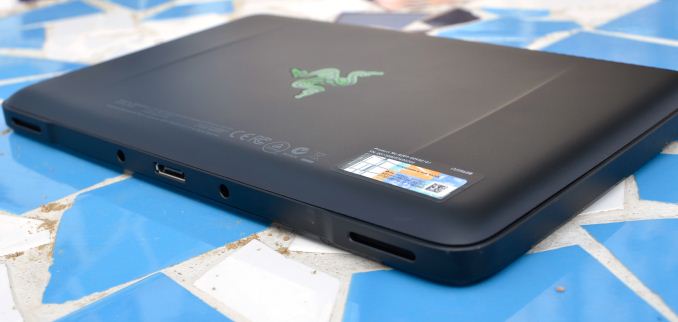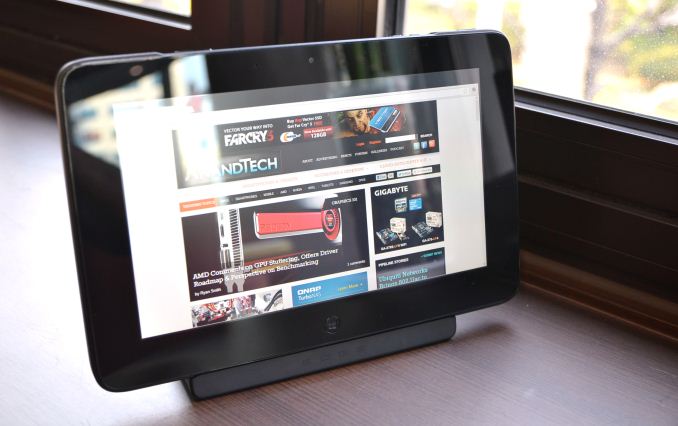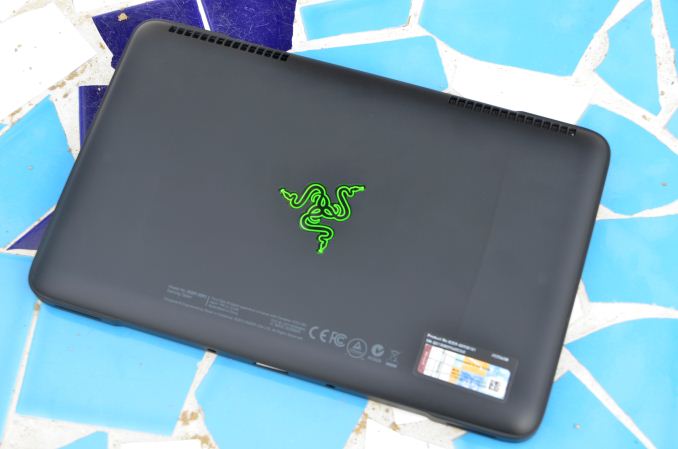The Razer Edge Review
by Vivek Gowri on March 28, 2013 11:00 AM EST- Posted in
- Tablets
- Mobile
- Razer
- Razer Edge
Design
The Edge will be pretty familiar to anyone who has seen or spent any time with Razer systems in the past – consider a tablet with the same design language as the Blade and you’ll be on the right track. Like the Blade that came before it, the design is clean and understated. The matte black anodized aluminum chassis looks actually like a shrunken version of the Blade lid, with the same vertical ridges flanking a glowing green Razer logo. The edges are all radiused, with two large vents on the right and left sides of the top edge (intake on the left, exhaust on the right). The sides of the tablet are unadorned, while the bottom has the dock/power connector located in the center and a pair of speakers located at the corners. The top edge of the tablet has buttons for power, keyboard, rotation, and volume, as well as a 3.5mm combo jack and a USB 3.0 port accented in the traditional Razer green. The front face is completely clean other than the webcam at the top and the circular Windows button located just under the display.
When you first pick it up, it seems pretty antithetical to the slim ARM-based tablets that we’ve gotten used to over the last few years. Even Intel-based tablets like Surface Pro have tried really hard to reach that level of thinness, but the Edge practically flaunts its chunky design. The thickness isn’t the problem I thought it would be going into the review, because quite honestly, the size doesn’t make it uncomfortable to use. The curved sides make for a good in-hand feel, and the Edge feels more comfortable than Surface Pro does. My biggest issue with Surface Pro is that it felt really heavy, but because the Edge weighs just as much and has a significantly larger chassis, it doesn’t have that same dense feel to it. The ridges on the back also play into the in-hand feel, the subtle curvature acts almost like a grip that helps you hold the tablet. It just has a nice, solid, reassuring feel to it when you pick it up.
Razer made a big deal out of the speakers when I last saw the Edge at CES. Tablet audio has been overlooked for the last few years, though it’s finally starting to get its share of attention. The Edge has enough room in the chassis to pack a pair of surprisingly good stereo speakers. Any time you get solid midrange and any semblance of bass out of a tablet or ultrabook, you should be thrilled – it doesn’t happen very often. The speakers on the Edge are clearly and distinctly louder and more defined than any tablet or ultrabook I’ve spent time with in recent times – iPad (even the mini, which has stereo speakers), Surface Pro, ATIV Smart PC and Smart PC Pro, Zenbook Prime, Aspire S7, you name it. They’re legitimately better than any other prominent device in this class.
I have a couple of nits to pick with the design. The first is the bezel around the display – it’s huge. Tablets tend to have larger bezels than we like on notebooks, and the display edge gestures in Windows 8 also have a role to play here, but there’s something to be said for the elegance of a slim bezel. The Edge has a bezel that’s just over an inch wide all the way around. That’s pretty substantial, even compared to the healthy 0.75” width of the iPad’s bezel. The generous bezel means that you’re never worried about accidentally touching the display, but I’d like to see a display closer in size to Surface’s 10.6” panel in this same size chassis. I’m not sure how feasible it is for a company like Razer to get a somewhat irregularly sized panel, though. I’d also be interested in seeing how much bigger the chassis would need to be to fit an 11.6” display, and I’m sure John Wilson and his team kicked that idea around before settling on the 10.1” panel. It’s clear that the ideal display size for Windows tablets is somewhere between 10.1” and 11.6”, so it’ll be interesting to see if more manufacturers take Microsoft’s lead and start shipping devices later this year with displays in the 10.6”-11.1” range.
The other is the Windows sticker on the back – I think they’d have been better off integrating that into the power brick the way ASUS has been doing with their design-oriented systems for some time now. Perhaps I was spoiled by the sleekness of the Blade’s 120W brick, but in comparison the off-the-shelf Chicony 65W AC adapter is ugly and looks like a cheap touch on an otherwise very polished product. I’d like to see something slimmer, like a downsized version of the Blade adapter, with the product stickers integrated to really complete the clean aesthetic the rest of the device has.














89 Comments
View All Comments
A5 - Thursday, March 28, 2013 - link
It seems like the 2nd generation of this will be way better, if what half of Intel is saying about Haswell and GT3e is true.VivekGowri - Thursday, March 28, 2013 - link
That's something I wanted to touch on in the conclusion but ran out of time/forgot: GT3e will make the second generation of this really, really interesting. Haswell/GT3e is going to be an awesome combination, but like Anand tweeted, it'll be a while (14nm in 2015) until we get a real best of both worlds solution.A5 - Thursday, March 28, 2013 - link
Yeah, it seems that way. Thanks for the reply.tech.noob.fella - Friday, March 29, 2013 - link
isnt gt3 only for desktops?? i thought gt2 was for portables like this machine...not sure thoughKristian Vättö - Friday, March 29, 2013 - link
GT3 is for laptops too (and even the GT3e). Intel has always focused the best IGPs to mobile CPUs because those systems are the most likely to only feature integrated graphics. Desktops often have a dGPU because there's no heat/space/battery issue, especially if the system is geared towards something graphics intensive (IGPs, even lower-end ones, are fine for basic use).TerdFerguson - Thursday, March 28, 2013 - link
I find this review to be overly generous. Hardware should be reviewed on its merits, not on whether or not you approve of the concept. Asking nearly $2k for this monstrosity is utterly unreasonable.VivekGowri - Thursday, March 28, 2013 - link
It starts at $999, and the most reasonable configuration is $1499 - this honestly isn't that much more than Surface Pro or any of the other high-end Windows 8 tablets. I'd much, much rather pay $1499 for Edge Pro + gamepad than $1199 for the ATIV Smart PC Pro + laptop dock. Surface Pro plus Type Cover for $1139 is probably an equally decent value, but significantly slower (i5/HD4000/4GB vs i7/GT640MLE/8GB) and plays in a completely different market.andrewaggb - Thursday, March 28, 2013 - link
The docks are still the killers for me. At a desk I want to run 2 monitors at 1080p each minimum, preferrably with both 1920x1200 or better. And a usb keyboard and mouse. I could have a dock setup like that at the work office and home office and just drop the tablet in wherever I'm at. Wouldn't care if the tablet screen was disabled when docked running 2 external displays.I would also like a transformer style keyboard dock so I could use it as a laptop.
When I can do all that, with an i7/8gb/256gb+ ssd, it will be sweet. It sucks because I'm sure it could be done now and nobody seems to have done it. Hopefully with haswell... but everybody keeps talking about haswell like it's the second coming, I'm worried it's not going to live up to our expectations.
zanon - Thursday, March 28, 2013 - link
Vivek mentioned Tb, and what you describe is one of the few areas where it'd be really interesting. The dock could itself have a standard graphics card, and thus drive multiple large screens and more powerful gaming while still allowing the tablet part to get away with much less graphics power.15th Warlock - Thursday, March 28, 2013 - link
I have to agree with Terd, while $999 may be the prize of entrance for the Edge experience, the review doesn't actually test the default battery configuration (regardless of it being the pro or non pro version).What this review shows us is a best scenario, using the $250 gamepad attachment and $70 extra battery, that's $320 over the original MSRP, so, even in this scenario you only get 2 hrs of gaming when not plugged to the wall.
The review fails to mention that out of the box this tablet offers only one hour of gaming, and perhaps, less than 3 hrs. of regular use, if razer offered the extra battery with the gamepad attachment it would be a more tolerable proposal, but nickel and diming gamers for the privilege to play for two hrs is way too much, not even Apple limits the user experience in such a way with their overpriced toys...